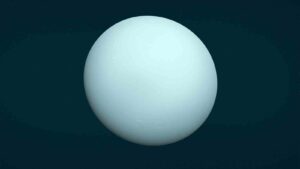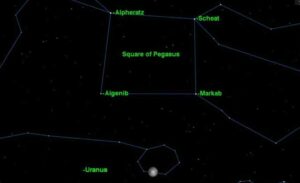*This post may contain affiliate links. This means we may make a commission if you purchase an item using one of our links*
If you’re here right now, you’ve probably seen the other more easily observable planets in, Mars, Saturn, Jupiter etc. and of course were curious about what you’d need to do in order to see Uranus through a telescope.
If so, you’ve come to the right place because in the article I will be covering the steps that are necessary particularly on how to locate and ultimately see Uranus with your own eyes.
To see Uranus with a telescope you’ll need access to a planet location software such a Stellarium, a telescope that can at least magnify between 100 – 200x, be in the ideal conditions and time where the skies are clear whilst attempting to observe it in the evenings of October till April or the Early mornings of May till late October.
I’ll explain in more detail how you should go about doing this with a few guide points to assist you along the way but, for the most part, what’s mentioned above is how you should go about locating the planet.
What Is Uranus?
Table of Contents

Uranus is a gas giant and is the 7th farthest planet from the Sun in our solar system. It’s also the third largest planet in our solar system with a surface area. Of 8.083 billion km², just behind the two largest gas giants in Jupiter and Saturn. In fact it’s roughly 5 times smaller than saturn and almost 8 times smaller, in surface area, than Jupiter.
Nevertheless, it’s still world’s bigger than our earth where it could fit a staggering 63 earth sized planets within it. The planets orbit comes in at 84 earth years, it’s gravity is actually only 86% of what Earth produces and its very cold too, coming in at an average of around -220 degrees Celsius.
The really low temperatures are of course the main reason why Uranus is commonly referred to as an ice giant.
One interesting fact about the planet and the reason why it comes across as blue in outer space is because its atmosphere is made out of hydrogen, helium and methane, where the inclusion of methane is the reason for its blue colour shift.
As for what the surface of the planet is made of, it’s mostly water, methane, and ammonia fluids so, not a particularly habitable environment to be in.
A couple other interesting things about the planet is that it actually has 2 very faint rings orbiting and was only discovered in 1781 by an individual named Sir William Herschel.
Anyhow let’s move on to the technical side of things, as in how you should go about locating the planet.
Can You See Uranus Without A Telescope?
Technically speaking individuals who have really great eyesight may just be able to spot the planet shining through, although at a very dim form but, for the most part and for most individuals it’ll pretty much be impossible to spot it without using equipment.
How Can You Locate Uranus
The best way to locate Uranus, as you can’t really spot it without a telescope, it would be by using software to guide you. The software I’m talking about in particular is a free one and recommended quite widely by the community. It’s called Stellarium.
All you need to do is type in the name of the planet you’re looking for, which in this case is Uranus, and it should show you the basic direction and coordinates you’ll need to follow in order to find it.
However even with software on your side, it’ll be tough to accurately do that so, I’ll just provide a run through on how you should start and eventually find your way to the planet, after all it is much smaller than 2 big planets in Saturn and Jupiter whilst also being a further distance away from Earth.
Firstly, the best times to catch the planet in night sky are as follows :
- January 1st – April 8th in the evenings
- May 12 – October 30 in the early morning sky
- October 31 – December 31 in the evening sky
As the orbit of the planet is so much longer than that of Earth, although there will be some variation of these dates over the years, the viewing periods shouldn’t be too different from the ones mentioned above for atleast a few years after 2020.
It’s also a relatively bright planet with an apparently magnitudes of +5.7 but compared to the 5 planets before it, it’s definitely significantly dimmer.

As for how you should go about locating. Uranus, you’d first want to locate the square of pegasus. This will generally be located at the southern sky (of the northern hemisphere) around the local midnight period whilst in the eastern sky you’ll be able to spot it in the evening.
After that you’ll want to use the 2 stars on the left, Alpheratz and Algenib, you’ll want connect a line between the 2 a draw line following the flow of the connection until you reach the bottom of the horizon.
This line should in turn go past 2 stars provided you’re in the right conditions, clear skies, the ideal viewing period for Uranus. The first star is an entity called 44 piscium, which will be on the left side of the line drawn and if you continue further down, it’s to the left of the side where you’ll finally spot Uranus.
What Equipment Will You Need To See Uranus
In order to view Uranus in pretty solid detail you’d need to invest in a very powerful device however, it is possible to make out the planet using a smaller telescope, although just barely.
The general findings is that in order to see Uranus as more than just a bright blue ball of light through your device, you’d need a system that can magnify at least 100x and depending on its distance from Earth, upto 200x in magnification to just barely make our the greeny – blue disk shape of the planet.
Now if you want to be able to see Uranus in some detail with a few cloud band stripes being visible along with a couple of its 27 moons, you’ll need to purchase a system that can amplify its power upto 500x+.
This will magnify the planet to the size of how we see a full moon however, due to turbulence and few other issues, achieving and maintaining such a high magnification number won’t be very practical in real world use.
Summary
Hopefully this article has helped you understand how to locate the planet and possibly even motivated you to give finding this ice giant a shot with a smaller or even larger telescope.
Unfortunately neither Uranus and Neptune are all that fun too look at so the novelty will likely wear off, as opposed to the massive gas giants in our solar system however, not everyone can claim they’ve seen Uranus floating in outer space with their very own eyes, which in and of itself is a pretty cool thing to have accomplished right?
So, if you do follow through with finding Uranus, at the very least you will have accomplished something that not many people in every day life will ever do!


Wanting to spot Uranus was an inspiration for me buying a telescope this year.
I’m still waiting for the planet to swing around in the sky where I live in London, but in the meantime I’ve enjoyed viewing many other planets including the crescent Venus and the gas giants, and even Comet Neowise.
The telescope is fairly basic (5 inch Newtonian) but I hope to at least spot Uranus and say that I’ve seen it!
Although it will be quite the challenge to view Uranus, if the conditions are ripe, if you’re utilising a good portion of the 5 inch telescopes power and if you’re able to keep the device stable enough at that high a magnification, I’m sure that you definitely should be able to see Uranus when it swings back around!